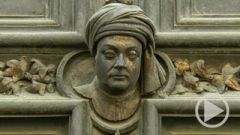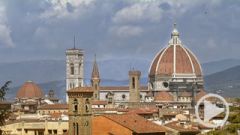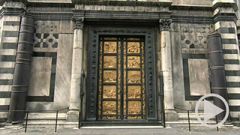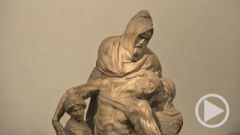- Home
- »
- Italy
- »
- Florence
- »
- Florence Cathedral
- »
- Florence Cathedral - Making the Impossible Possible
Making the Impossible Possible
Making the Impossible Possible
In the year 1401, Pippo Brunelleschi is a grown man. He’s completed an apprenticeship as a goldsmith, and this makes him versatile, as someone with an appreciation of aesthetic matters, as well as knowledge of metalwork and mechanics. He is brimming with self-confidence. And he gets his big chance – in yet another competition. The next portal of the baptistery is to be cast in bronze.
Filippo submits a design, one that the jury admires with astonishment, before rejecting it. The commission is awarded to a colleague of almost the same age, who is also a goldsmith: Lorenzo Ghiberti. The two designs are on show today at the Museo del Bargello. They were so superior to all the other submissions that the jury ended up choosing between the two. Both designs relate the story stipulated by the construction authority: Abraham rides with Isaac to the sacrificial site – ready to sacrifice his own son if it is God’s will. At the last moment however, God stops him and sends a lamb instead.
Lorenzo Ghiberti’s design appears more balanced, with a coherent group of figures harmoniously integrated into the available space. The scene is divided up along diagonal lines – down on the left are father and son on their way to the sacrificial site. On the right we see Abraham preparing to sacrifice Isaac. Right at the top, the angel brings him the redemptive lamb.

Brunelleschi’s figures on the other hand appear to want to break free of their confines. He accentuates the drama of the situation: Abraham has already put his knife to Isaac’s throat –at the very last moment the angel appears. It is a more modern interpretation of the story, more gripping than that of Ghiberti. Both artists draw on the art of the Antiquity, which is experiencing a revival at that time. Brunelleschi even incorporates a specific motif: the figure on the bottom left is reminiscent of the famous Spinario, or boy with thorn.
Although Filippo’s design is viewed as the second-best, he is deeply insulted by the defeat. This is according to the architect and mathematician Antonio Manetti, later Filippo’s friend and successor. He has provided us with the oldest report on the life of Brunelleschi. A hundred years later, this biography was embellished by the famous Giorgio Vasari. He relates how the frustrated Filippo moves to Rome after losing the competition – together with a young apprentice of sculpture named Donatello. The pair make a great team: both of them are hot-headed and stubborn – and both will go on to ring in the Renaissance in their own particular field.
Together, the friends wander through the Roman ruins. The Eternal City is certainly looking a little worse for wear. While it used to have one and a half million residents, now its population has shrunk to just 20 thousand. They dwell in a small settlement on the banks of the Tiber, afflicted by malaria and plague. They despise the ancient ruins as the vestiges of pagan idolatry. They destroy many of them out of superstition – or simply use them as quarries.

Filippo and Donatello see things differently. For them, the old walls are not the work of the devil, but examples of great architecture. Disguised as treasure hunters, the two men take a very close look at the majestic remains. Filippo Brunelleschi seeks direct inspiration from the architecture of the Antiquity, the first architect since the Migration Period to do so.
He is especially fascinated by the Pantheon. At this time, it’s almost 1,300 years old, and its cupola is still the largest in the world. Perhaps Filippo finds some clues here as to how one might repeat such an architectural feat in Florence. Unfortunately what he sees doesn’t help him much. The Romans cast the cupola from concrete – but the technique has been long forgotten. There are even rumours in the Holy City that the Pantheon was built by the Devil’s own hand.
Several years later, Filippo returns to Florence with a head full of new ideas. Firstly, he ushers in a revolution in painting, by developing central perspective. The technique at last makes it possible to realistically portray spatial depth on pictures and reliefs. Filippo’s drawings have unfortunately since been lost – although they were a sensation at the time. Meanwhile work on building the cathedral has progressed. The old Santa Reparata church has been demolished, and services are being held in the new nave. Although it is only half-finished, the church leaves an overwhelming spatial impression. With a length of 153 metres, it is to become the largest of its epoch – and even today, 600 years later, Florence Cathedral is the world’s fourth largest church.

Since 1412, it is officially no longer dedicated to Reparata, but the Mother of God. “Santa Maria del Fiore”, or “Saint Mary of the Flower”. The flower is on the one hand a reference to her son Jesus, who is often portrayed as a flower on the family tree of Jewish kings. On the other hand, the dedication is an allusion to the city itself, founded by the Romans as “Florentia”, which means “the flourishing one”. But the cathedral is still just a torso. No one is any the wiser as to how to build the massive cupola over the crossing.
In the year 1418, the wool barons finally resort to a tried and tested solution, and announce another competition. Submissions are received from the best architects, including Filippo’s old rival Lorenzo Ghiberti. He has in the meantime become one of Italy’s most famous artists. Filippo himself is also on board. Although he has absolutely no experience as an architect, he has big ideas. And the winner of this competition is guaranteed celebrity status.
It’s hard to appreciate today what an incredible challenge the Florentines had set themselves. No one had even attempted to build a dome of anything like these dimensions since Antiquity. They envisage it rising up over the vaults of the church naves. And to heighten its majestic impact, the Florentines have also placed a 10-metre tambour on the crossing. At a height of 52 metres, the design foresees eight interlocking vaults –a typical Gothic building technique, known as a “cloister vault”. In itself, nothing new.
But the tallest Gothic vaults ever built, in Beauvais Cathedral, are only 48 metres tall at their apex. And the Florentines plan to start erecting their dome at a point four metres higher than that! What‘s more, Beauvais Cathedral was never completed. Most of the vaults collapsed after just 10 years. And that’s with a span of just 15 metres. The design for the dome at Florence foresees a diameter of almost 45 metres – three metres more than the Pantheon!
Added to this, a technical problem: vaults are usually built on wooden templates, a technique known as “centering”. The templates support the stones while the mortar hardens. The centering templates for the Florence dome would have to be unimaginably large, a full 90 metres high, as well as support a massive weight: the cupola today weighs around 37 thousand tonnes. A huge scaffold such as this would require 700 enormous tree trunks – and although the cathedral construction authority owns an entire forest, the cost is too great even for the wealthy Florentines.

But there’s no other way of building it. The forefathers had hoped that God would one day communicate the right design to someone. Is Filippo Brunelleschi that someone? For the wool magnates he seems an unlikely candidate.
At the age of 41, Filippo has never worked as an architect. Worse still: instead of coming up with a sensible suggestion for the construction of the centering, he submits a risible plan, claiming to be able to build the cupola WITHOUT a centering at all!
And as if that isn’t enough, he’s demanding that they simply snap up this crazy idea. He’s frightened that someone might steal his designs – and that’s why he’s not prepared to explain in detail how he would tackle the job. The only thing he DOES say is that the cupola will consist of two shells. The internal shell supports the actual weight, while the external one protects and strengthens the cupola. The two shells are connected by a system of ribs.
The jurors are faced with a dilemma. Should they take Filippo’s word for it, that he can achieve something that is utterly impossible? Or should they favour a more conventional approach – although they know that this cannot work? They initially do the most obvious thing, namely: nothing.
Meanwhile Filippo wins his first architectural commission, to build the “Ospedale degli Innocenti”, the city’s new orphanage. And he immediately demonstrates his mastery. Clear, geometric forms, classically balanced proportions, windows and slender pillars that lend a regular structure to the façade – Brunelleschi’s building is viewed today as the first true Renaissance construction.
More than a year goes by before the jurors at the cathedral construction authority make a Solomonic decision. They select Filippo’s model and appoint him to the post of new master builder. There’s simply no alternative. But at the same time, they appoint a second master builder of equal rank: Lorenzo Ghiberti. Of all people, Ghiberti, his arch rival! Filippo is exasperated. Over the decades that follow, he’ll channel a great deal of energy into getting rid of his competitor. And eventually, he’ll almost succeed in doing just that.

But before construction can begin, there’s yet another practical problem to be solved: how to transport blocks of stone weighing almost one thousand kilograms up to such dizzying heights? Up to now this had been done using pulleys driven by labourers in treadmills. But with such heights involved, that’s not going to work. And even when the stones are up on the walls – how can they be maneuvered precisely into position? These questions were all part of the competition. But none of the entrants has come up with any answers – apart from Filippo, that is.
He’s been fascinated by mechanics all his life. Antonio Manetti reports that he constructed clocks, and that he even built the first ever alarm clock known to humankind. Now he’s presenting designs for machines that leave his fellow men speechless. Buonaccorso Ghiberti, Lorenzo’s grandson, captured them in drawings. For decades, they are admired across Europe. But Filippo is again afraid that someone might steal his ideas. That’s why he arranges for each component to be built by a different craftsman, and for the all the work to be done outside Florence.
The first machine to be unveiled in the summer of 1420 was a freight elevator, the likes of which no one had ever seen before. The crane rope alone weighs half a tonne. It’s 180 metres long – the largest cable manufactured to date. Only the shipbuilders of Pisa are able to make something like this.
The crane itself is not powered by humans, but by oxen. They are patient and strong. The only problem: they cannot be persuaded to go backwards to lower the rope. Filippo comes up with a brilliant solution: the drive shaft can be adjusted – so the elevator gets a forward and a reverse gear while the oxen always walk in the same direction.

At a height of 90 metres, the second miracle machine takes over the load. “Il Castello” looks amazingly like a contemporary crane. On a wooden mast there’s a revolving boom – that’s where the crane operators stand, at breathtaking heights, tossed about by the wind! Using a shaft, they can move their platform inwards and outwards, with a counterweight simultaneously moving on the other side. Immense forces are being exerted on all these constructions. But physical calculations are completely unknown – all Filippo can do is rely on his instincts. And they must be outstandingly good, because both cranes function without the need for major repairs throughout the entire construction period.
Building work begins on August 7th, 1420. Eight teams of masons work simultaneously on all sides of the dome. The competition has dragged on for a long time, and things really have to get moving now. Workers are not even allowed to climb down for a lunchbreak – Filippo arranges for a canteen to be set up between the shells of the cupola.
The statics of the huge dome present an enormous challenge. The outward pressure generated by its own weight is one of the biggest problems facing any dome construction project. Filippo has chains of sandstone beams laid at regular intervals along the walls’ outer edges. And immediately above the first chain of stones he mounts a chain of chestnut wood beams. It stabilises the dome even in the event of an earthquake, as wood is more flexible and tension-proof than stone.
The construction of this chain of beams provides Filippo with the opportunity to scheme against his co-architect. He’s still niggled by the fact that Lorenzo Ghiberti is paid the same wage – although all the ideas are his.
Suddenly, Filippo falls critically ill. Lorenzo has to continue the work alone. But the chain is a complicated construction. And as usual, Filippo has let nobody in on the subtleties of his designs – least of all Ghiberti. Not surprisingly, Lorenzo struggles to cope. After a few weeks, Filippo makes a miraculous recovery – and inspects Lorenzo’s botch-job with a demonstrative shake of the head. And indeed, the original pay sheets show that Ghiberti’s wage was actually docked completely after this little performance. The Opera administrators soon reverse their decision, but from now on, Filippo is in sole charge of the cupola project.






